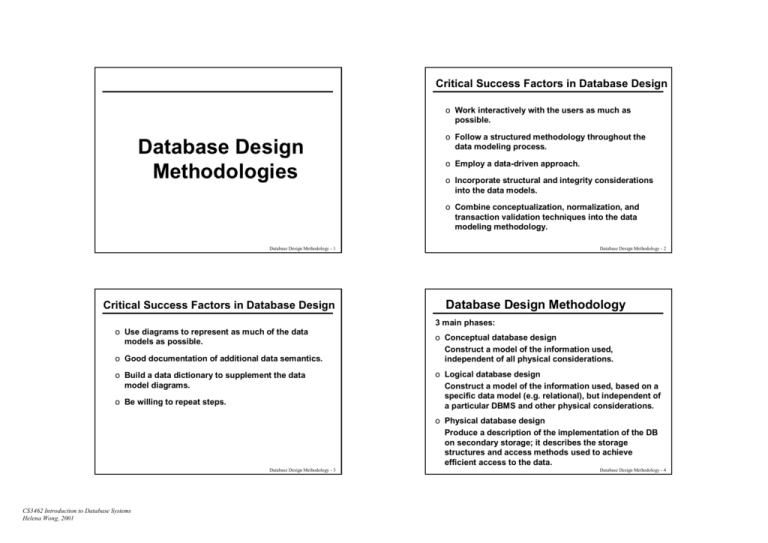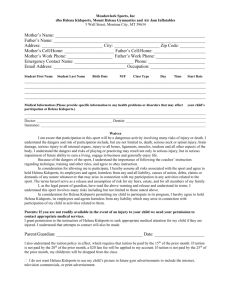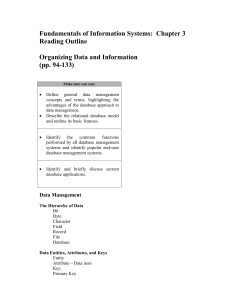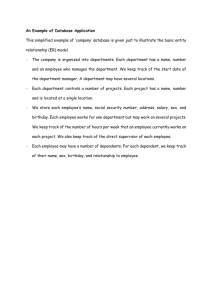Database Design Methodologies: A Structured Approach
advertisement

Critical Success Factors in Database Design o Work interactively with the users as much as possible. Database Design Methodologies o Follow a structured methodology throughout the data modeling process. o Employ a data-driven approach. o Incorporate structural and integrity considerations into the data models. o Combine conceptualization, normalization, and transaction validation techniques into the data modeling methodology. Database Design Methodology - 1 Critical Success Factors in Database Design Database Design Methodology - 2 Database Design Methodology 3 main phases: o Use diagrams to represent as much of the data models as possible. o Good documentation of additional data semantics. o Build a data dictionary to supplement the data model diagrams. o Be willing to repeat steps. o Conceptual database design Construct a model of the information used, independent of all physical considerations. o Logical database design Construct a model of the information used, based on a specific data model (e.g. relational), but independent of a particular DBMS and other physical considerations. o Physical database design Produce a description of the implementation of the DB on secondary storage; it describes the storage structures and access methods used to achieve efficient access to the data. Database Design Methodology - 3 CS3462 Introduction to Database Systems Helena Wong, 2001 Database Design Methodology - 4 Methodology Overview Methodology Overview - Conceptual Database Design Step 1 Build local conceptual data model for each user view Step 2 Build and Validate Local Logical Data Model Step 3 Build and Validate Global Logical Data Model Step 4 Translate Global Logical Data Model for Target DBMS Step 5 Design Physical Representation Step 6 Design and Implement Security Mechanisms Step 7 Monitor and Tune the Operational System Step 1 Build local conceptual data model for each user view Step 1.1 Identify entity types Step 1.2 Identify relationship types Step 1.3 Identify and associate attributes with entity or relationship types Step 1.4 Determine attribute domains Step 1.5 Determine candidate and primary key attributes Step 1.6 Specialize/generalize entity types (optional step) Step 1.7 Draw Entity–Relationship diagram Step 1.8 Review Local Conceptual Data Model with User Database Design Methodology - 5 Database Design Methodology - 6 Methodology Overview – Logical Database Design for Relational Model Methodology Overview – Logical Database Design for Relational Model Step 2 Step 3 Build and Validate Local Logical Data Model Build and Validate Global Logical Data Model Step 2.1 Map Local Conceptual Data Model to Local Logical Data Model Step 3.1 Merge Local Logical Data Models into Global Model Step 2.2 Derive Relations from Local Logical Data Model Step 3.2 Validate Global Logical Data Model Step 2.3 Validate Model using Normalization Step 3.3 Check for Future Growth Step 2.4 Validate Model against User Transactions Step 3.4 Draw Final Entity-Relationship Diagram Step 2.5 Draw Entity-Relationship Diagram Step 3.5 Review Global Logical Data Model with Users Step 2.6 Define Integrity Constraints Step 2.7 Review Local Logical Data Model with User Database Design Methodology - 7 CS3462 Introduction to Database Systems Helena Wong, 2001 Database Design Methodology - 8 Methodology Overview – Physical Database Design for Relational Databases Methodology Overview – Physical Database Design for Relational Databases Step 4 Step 6 Translate Global Logical Data Model for Target DBMS Step 4.1 Design Base Relations for Target DBMS Design and Implement Security Mechanisms Step 6.1 Design User Views Step 4.2 Design Integrity Rules for Target DBMS Step 6.2 Design Access Rules Step 5 Step 7 Design Physical Representation Monitor and Tune the Operational System Step 5.1 Analyze Transactions Step 5.2 Choose File Organization Step 5.3 Choose Secondary Indexes Step 5.4 Consider the Introduction of Controlled Redundancy Step 5.5 Estimate Disk Space Database Design Methodology - 9 Step 1.1 Identify entity types Branch Staff Supervisor Secretary Property_for_Rent Private_Owner Business_Owner Step 1.2 Identify relationship types Advert Newspaper Interview Client Lease_Agreement Inspection Database Design Methodology - 11 CS3462 Introduction to Database Systems Helena Wong, 2001 Database Design Methodology - 10 Database Design Methodology - 12 Step 1.2 Identify relationship types Step 1.2 Identify relationship types o Branch Has Staff Relationship o Property_for_Rent DescribedIn Advert relationship o Staff Manages Property_for_Rent relationship Database Design Methodology - 13 o Client Views Property_for_Rent relationship Database Design Methodology - 14 Sketch of Supervisor's Local Conceptual Data Model Step 1.3 Identify and associate attributes with entity or relationship types Database Design Methodology - 15 CS3462 Introduction to Database Systems Helena Wong, 2001 Database Design Methodology - 16 Step 1.3 Identify and associate attributes with entity or relationship types Step 1.4 Determine attribute domains o For attributes in the Supervisor’s local conceptual data model of the DreamHome company. (e.g. Domain of Branch_No attribute of Branch entity includes a three-character string, with values ranging from B1 to B99). Database Design Methodology - 17 Step 1.5 Determine candidate and primary key attributes Database Design Methodology - 19 CS3462 Introduction to Database Systems Helena Wong, 2001 Database Design Methodology - 18 Step 1.6 Specialize / Generalize Entity Types (Optional Step) Database Design Methodology - 20 Step 1.6 Specialize / Generalize Entity Types (Optional Step) Step 1.6 Specialize / Generalize Entity Types (Optional Step) Additional Example Additional Example Database Design Methodology - 21 Database Design Methodology - 22 Step 1.7 Draw Supervisor's Local Conceptual Data Model Step 2.1 Map Local Conceptual Data Model to Local Logical Data Model To refine the local conceptual data model to remove undesirable features and to map this model to a local logical data model: (a) Remove M:N relationships. (b) Remove complex relationships. (c) Remove recursive relationships. (d) Remove relationships with attributes. (e) Remove multi-valued attributes. (f) Re-examine 1:1 relationships. (g) Remove redundant relationships. Database Design Methodology - 23 CS3462 Introduction to Database Systems Helena Wong, 2001 Removing data structures that are difficult to implement in relational databases. Database Design Methodology - 24 Removing Advertises M:N Relationship Database Design Methodology - 25 Removing Supervises Recursive Relationship Database Design Methodology - 27 CS3462 Introduction to Database Systems Helena Wong, 2001 Removing Leases Complex Relationship Database Design Methodology - 26 Removing WorksAt Relationship with Hours_Worked Attribute Database Design Methodology - 28 Removing Tel_No Multi-valued Attribute Non-Redundant Relationships A relationship is redundant if the same information can be obtained from other relationships. Database Design Methodology - 29 An Example Logical Data Model Database Design Methodology - 31 CS3462 Introduction to Database Systems Helena Wong, 2001 Database Design Methodology - 30 Supervisor's local logical data model (Version 1) Database Design Methodology - 32 Step 2.2 Derive Relations From Local Logical Data Model Step 2.2 Derive Relations From Local Logical Data Model o Strong Entity Types: create a relation that includes all simple attributes. o 1:1 Relationship Types: post a copy of the primary key attribute(s) of entity E1 into the E2 relation, to act as a foreign key. (The indentification of E1 and E2 depends on the participation constraints) Eg. Staff(Staff_No, FName, LName, Street, City, Postcode, Position, Sex, Salary) Eg. - Staff(Staff_No, Fname, Lname, ..) o Week Entity Types: create a relation that includes all simple attributes. In addition, include as a foreign key the primary key of the owner entity. - Branch (Branch_No, Address, .., Manager_No), Foreign Key Manager_No references Staff(Staff_No) Eg. Next-of-Kin (Staff_No, NName, Address, Tel_No, Relationship), Foreign key Staff_No references Staff(Staff_No) Database Design Methodology - 33 Step 2.2 Derive Relations From Local Logical Data Model Database Design Methodology - 34 Step 2.2 Derive Relations From Local Logical Data Model o Superclass/subclass relationships: o 1:M Relationship Types of E1 to E2: post a copy of the primary key attribute(s) of entity E1 into the E2 relation, to act as a foreign key. Eg. – Branch (Branch_No, Address, ..) – Staff (Staff_No, Fname, .. Branch_No), Foreign Key Branch_No references Branch (Branch_No) Database Design Methodology - 35 CS3462 Introduction to Database Systems Helena Wong, 2001 Example 1: All_Property(Property_No, Address, Type, Rent, Price) Example 2: Property_For_Rent(Property_No, Address, Type, Rent) Property_For_Sale(Property_No, Address, Type, Price) Example 3: Property(Property_No, Address, Type) Property_For_Rent(Property_No, Rent), Foreign Key Property_No references Property(Property_No) Property_For_Sale(Property_No, Price), Foreign Key Property_No references Property(Property_No) Database Design Methodology - 36 Step 2.3 Validate Model using Normalization To ensure that each relation derived from the logical data model is in at least Boyce-Codd Nornal Form. Issues: o A normalized design organizes the data according to its functional dependencies => lies somewhere between conceptual and physical design o The logical design may not be the final design. Eg. some normalized relations are denormalized in the physical design. Step 2.4 Validate Model Against User Transactions To ensure that the logical data model supports the transactions that are required by the user view. Example transactions (a) Insert details for new members of staff. (b) Delete details of a member of staff, given the staff number. o Normalization forces us to understand completely each attribute. o A normalized design is free of update anomalies, and the DB can be easily extended. Database Design Methodology - 37 Supervisor's local logical data model displaying the transactions supported Step 2.5 Draw Supervisor's local logical data model (Final Version) Database Design Methodology - 39 CS3462 Introduction to Database Systems Helena Wong, 2001 Database Design Methodology - 38 Database Design Methodology - 40 Step 3.1 Merge Local Logical Data Models into Global Models Comparison of entities and their primary keys in Supervisor’s and Manager’s views (a) Review the names of entities and their primary keys. (b) Review the names of relationships. (c) Merge entities from the local views. (d) Include (without merging) entities unique to each local view. (e) Merge relationships from the local views. (f) Include (without merging) relationships unique to each local view. (g) Check for missing entities and relationships. (h) Check foreign keys. (i) Check Integrity Constraints. (j) Draw the global logical data model. (k) Update the documentation. Database Design Methodology - 41 Comparison of relationships in Supervisor’s and Manager’s views Database Design Methodology - 43 CS3462 Introduction to Database Systems Helena Wong, 2001 Database Design Methodology - 42 Merging the Staff entities from Supervisor's and Manager's views Database Design Methodology - 44 Merging the Advert entities from Supervisor's and Manager's views Database Design Methodology - 45 Step 3.4 Draw Global logical data model of DreamHome case study Step 3.1 Merge Local Logical Data Models into Global Models Database Design Methodology - 46 Physical Database Design (Steps 4-7) o Sources of information for the physical design process includes global logical data model and documentation that describes model. o Logical database design is concerned with the what, physical database design is concerned with the how. o Physical Database Design is the process of producing a description of the implementation of the database on secondary storage. o Describes the storage structures and access methods used to achieve efficient access to the data. Database Design Methodology - 47 CS3462 Introduction to Database Systems Helena Wong, 2001 Database Design Methodology - 48 Step 4 Translate Global Logical Data Model for Target DBMS Step 5 Design Physical Representation o Typical Disk Configuration Database Design Methodology - 49 Step 5.1 Analyze transactions Database Design Methodology - 50 ER Model for Sample Transactions showing Expected Occurrences Example - Sample Transactions (A) Insert details for a new member of staff, given the branch address. (B) List rental properties handled by each staff member at a given branch address. (C) Assign a rental property to a member of staff, checking that a staff member does not manage more than 10 properties already. (D) List rental properties handled by each branch office. Database Design Methodology - 51 CS3462 Introduction to Database Systems Helena Wong, 2001 Database Design Methodology - 52 Transaction Usage Map for Sample Transactions Database Design Methodology - 53 Analysis of Selected Transaction B Database Design Methodology - 55 CS3462 Introduction to Database Systems Helena Wong, 2001 Analysis of Selected Transaction A Database Design Methodology - 54 Analysis of Selected Transaction C Database Design Methodology - 56 Step 5.4 Consider introducing controlled redundancy Example 1: Example 2: Combined renter and interview relations Database Design Methodology - 57 Step 5.4 Consider introducing controlled redundancy Example 2: Duplicating LName attribute in the Property_for_Rent relation Database Design Methodology - 59 CS3462 Introduction to Database Systems Helena Wong, 2001 Step 5.4 Consider introducing controlled redundancy Database Design Methodology - 58 Step 5.5 Estimate disk space requirements o Lookup Table for Property_Type Attribute Database Design Methodology - 60 Step 5.5 Estimate disk space requirements o Comparison of Space Requirements for Property_for_Rent Relation Database Design Methodology - 61 CS3462 Introduction to Database Systems Helena Wong, 2001






